Title search results
Showing 1 - 20 of 4290 items
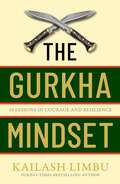
The Gurkha Mindset: 10 Lessons in Courage and Resilience
By Captain Kailash Limbu. 2025
The Gurkha Mindset distils the wisdom and experiences of a seasoned Gurkha soldier into ten powerful lessons for life and…
leadership.Drawing from over two decades of service in the British Army, including five tours in Afghanistan and deployments in Bosnia and Sierra Leone, Captain Kailash Limbu shares the core principles that have shaped his journey as a soldier and a man. Through the metaphor of the khukuri, a symbolic and essential tool for every Gurkha, he illustrates how mindset and behaviour are crucial to overcoming challenges, achieving success and leading with honour.Kailash reveals how the disciplined and courageous mindset of the Gurkhas can be applied to everyday life, helping readers manage emotions, foster teamwork, lead effectively and prioritise self-care. Each lesson is rooted in the simplicity and strength of the Gurkha way of life, offering practical insights that are both timeless and adaptable to any context.Whether you seek to enhance your personal life, advance in your career or simply find greater fulfilment, The Gurkha Mindset provides the tools to sharpen your focus, build resilience and embrace life's challenges with a warrior's spirit.
The Bomber Boys: Heroes Who Flew the B-17s in World War II
By Travis L. Ayres. 2005
True tales of heroism and the men who fought and died in the skies of World War II Europe.In World…
War II, there were all too many ways for a fighting man to die. But no theater of operations offered more fatal choices than the skies above Nazi-occupied Europe. Inside of a B-17 Bomber, thousands of feet above the earth, death was always a moment away. From the hellish storms of enemy flak and relentless strafing of Luftwaffe fighters, to mid-air collisions, mechanical failure, and simple bad luck, it&’s a wonder any man would volunteer for such dangerous duty. But some very brave men did. Some paid the ultimate price. Some made it home. But in the end, all would achieve victory. Here, author Travis L. Ayres has gathered a collection of previously untold personal accounts of combat and camaraderie aboard the B-17 Bombers that flew countless sorties against the enemy, as related by the men who lived and fought in the air—and survived. They are stories of heroism, sacrifice, miraculous survival and merciless warfare. But they should all be remembered...INCLUDES PHOTOS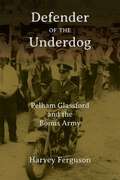
Defender of the Underdog: Pelham Glassford and the Bonus Army
By Harvey Ferguson. 2023
In 1932, the worst year of the Great Depression, more than twenty thousand mostly homeless World War I veterans trekked…
to the nation&’s capital to petition Congress to grant them early payment of a promised bonus. The Hoover Administration and the local government urged Washington, DC, police chief Pelham Glassford to forcefully drive this &“bonus army&” out of the city. Instead, he defied both governments for months and found food and shelter for the veterans until Congress voted on their request.Glassford&’s efforts to persuade federal and local officials to deal sympathetically with the protesters were ultimately in vain, but his proposed solutions, though disregarded by his supervisors, demonstrate that compassion and empathy could be more effective ways of dealing with radical protests than violent suppression.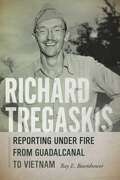
Richard Tregaskis: Reporting under Fire from Guadalcanal to Vietnam
By Ray E. Boomhower. 2021
In the late summer of 1942, more than ten thousand members of the First Marine Division held a tenuous toehold…
on the Pacific island of Guadalcanal. As American marines battled Japanese forces for control of the island, they were joined by war correspondent Richard Tregaskis. Tregaskis was one of only two civilian reporters to land and stay with the marines, and in his notebook he captured the daily and nightly terrors faced by American forces in one of World War II&’s most legendary battles—and it served as the premise for his bestselling book, Guadalcanal Diary.One of the most distinguished combat reporters to cover World War II, Tregaskis later reported on Cold War conflicts in Korea and Vietnam. In 1964 the Overseas Press Club recognized his first-person reporting under hazardous circumstances by awarding him its George Polk Award for his book Vietnam Diary. Boomhower&’s riveting book is the first to tell Tregaskis&’s gripping life story, concentrating on his intrepid reporting experiences during World War II and his fascination with war and its effect on the men who fought it.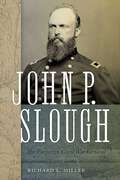
John P. Slough: The Forgotten Civil War General
By Richard L. Miller. 2021
John Potts Slough, the Union commander at the Battle of Glorieta Pass, lived a life of relentless pursuit for success…
that entangled him in the turbulent events of mid-nineteenth-century America. As a politician, Slough fought abolitionists in the Ohio legislature and during Kansas Territory&’s fourth and final constitutional convention. He organized the 1st Colorado Volunteer Infantry after the Civil War broke out, eventually leading his men against Confederate forces at the pivotal engagement at Glorieta Pass. After the war, as chief justice of the New Mexico Territorial Supreme Court, he struggled to reform corrupt courts amid the territory&’s corrosive Reconstruction politics.Slough was known to possess a volcanic temper and an easily wounded pride. These traits not only undermined a promising career but ultimately led to his death at the hands of an aggrieved political enemy who gunned him down in a Santa Fe saloon. Recounting Slough&’s timeless story of rise and fall during America&’s most tumultuous decades, historian Richard L. Miller brings to life this extraordinary figure.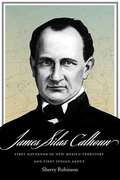
James Silas Calhoun: First Governor of New Mexico Territory and First Indian Agent
By Sherry Robinson. 2021
Veteran journalist and author Sherry Robinson presents readers with the first full biography of New Mexico&’s first territorial governor, James…
Silas Calhoun. Robinson explores Calhoun&’s early life in Georgia and his military service in the Mexican War and how they led him west. Through exhaustive research Robinson shares Calhoun&’s story of arriving in New Mexico in 1849—a turbulent time in the region—to serve as its first Indian agent. Inhabitants were struggling to determine where their allegiances lay; they had historic and cultural ties with Mexico, but the United States offered an abundance of possibilities.An accomplished attorney, judge, legislator, and businessman and an experienced speaker and negotiator who spoke Spanish, Calhoun was uniquely qualified to serve as the first territorial governor only eighteen months into his service. While his time on the New Mexico political scene was brief, he served with passion, intelligence, and goodwill, making him one of the most intriguing political figures in the history of New Mexico.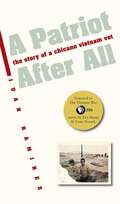
A Patriot After All: The Story of a Chicano Vietnam Vet
By Juan Ramirez. 1999
Juan Ramirez always believed he would die in Vietnam. As a teenager growing up in the San Francisco area in…
the early 1960s, Nam was there, just over the horizon, like the distant thump of artillery. His father and uncles had served in World War II, another uncle in Korea. Numerous cousins had enlisted. At nineteen, Ramirez decided to embrace the war. In 1968, the year of the Tet offensive, Ramirez joined the U.S. marines.Two bloody tours later, Ramirez survived, but at immense cost. Twice wounded, undesirably discharged, and plagued by survivor's guilt, Ramirez surveys the toll of Vietnam on flesh and spirit in this captivating memoir.Ramirez tells his story in a voice not often heard from the war, that of a Chicano soldier. By tracing his roots, and exploring the cultural pressures and social demons that weighed on his family and community, Ramirez offers an unflinching look at the fall and redemption of one Mexican American veteran.Ramirez has given us a rather unique and clear-eyed view inside the life and times and thoughts of a young Chicano who joins the marines and goes to Vietnam to find his destiny. . . . Fascinating reading.--Joseph L. Galloway, author of We Were Soldiers Once . . . And Young.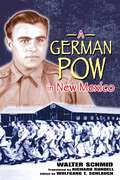
A German POW in New Mexico (Historical Society of New Mexico Publication Series)
By Walter Schmid. 2005
Walter Schmid, a member of Rommel's Afrika Korps, was one of hundreds of thousands of POWs interned in the United…
States during World War II. Drafted into the German army at twenty, he had fought for only five months when captured in Tunisia in May 1943. Schmid was sent first to POW camps in Oklahoma (Gruber, Bixby, and McAlester) and was soon transferred to New Mexico in July 1944.Walter Schmid worked in southern New Mexico's Mesilla Valley picking cotton and harvesting melons alongside Mexican-American laborers. He recalls playing trumpet in the camp orchestra and watching Sunday soccer games between the teams of rival POW camps. Based on his diary and the letters he sent home to his German girlfriend, whom he later married, Schmid's memoir was published in Germany in 2000. This abbreviated English translation begins with his capture in North Africa and his voyage to the United States and ends with his work experience in England, where he was transferred after almost three years of captivity in the United States, and his return to Germany in 1947.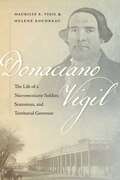
Donaciano Vigil: The Life of a Nuevomexicano Soldier, Statesman, and Territorial Governor
By Helene Boudreau, Maurilio E. Vigil. 2022
Born in Santa Fe in 1802, Donaciano Vigil was an active participant in many of the critical events in New…
Mexico&’s history in the nineteenth century. Vigil was witness to New Mexico&’s transition from a Spanish province (1802–1821) to a Mexican department (1821–1846) and eventually to an American territory (1846–1877), and he was a key player in most of the events of that era. As a Hispano soldier and officer in the New Mexico Militia, he was instrumental in the Navajo Wars, the Rio Arriba insurrection of 1837, the Texas invasion of 1841, and the American invasion of 1846. As a Mexican statesman in New Mexico, he was one of the most active assemblymen. Following the American occupation, he joined the civil government, first as secretary, then as governor. It was in these roles that Donaciano left an enduring impact and legacy on the territory.In this gripping biography of a remarkable man, Maurilio E. Vigil and Helene Boudreau fill the gap within the scholarship on Hispanics in nineteenth-century New Mexico.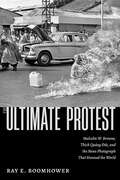
The Ultimate Protest: Malcolm W. Browne, Thich Quang Duc, and the News Photograph That Stunned the World
By Ray E. Boomhower. 2024
The Ultimate Protest: Malcolm W. Browne, Thich Quang Duc, and the News Photograph That Stunned the World examines how the…
most unlikely of war correspondents, Malcolm W. Browne, became the only Western reporter to capture Buddhist monk Thich Quang Duc's horrific self-immolation on June 11, 1963. Quang Duc made his ultimate sacrifice to protest the perceived anti-Buddhist policies of the Catholic-dominated administration of South Vietnam's president Ngo Dinh Diem.Biographer Ray E. Boomhower's The Ultimate Protest explores the background of the Buddhist crisis in South Vietnam in the spring of 1963 that led to Quang Duc's self-sacrifice as well as the worldwide reaction to Browne's photograph, how it affected American policy toward Diem's government, and the role the image played in the violent coup on November 1, 1963, that deposed Diem and led to his assassination. The book also delves into the dynamics involved in covering the Vietnam War in the early days of the American presence and the pressures placed on the journalists to stop raising doubts about how the war was going. Browne and his colleague David Halberstam shared the 1964 Pulitzer Prize for international reporting for their work in Vietnam.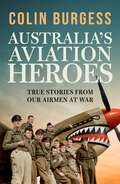
Australia's Aviation Heroes: True stories from our airmen at war
By Colin Burgess. 2025
From the author of bestselling Sisters in Captivity, seven remarkable stories of men who served from WWI to Korea –…
their wartime exploits and achievements through aviation. Based on personal interviews conducted by the author over many years, Australia&’s Aviation Heroes celebrates the achievements of extraordinary men in extraordinary times. Meet Jack Treacy, the WWI fighter pilot who came perilously close to joining the Red Baron in his grave. Relive the story of Ernie Guest, a man determined to fly against all odds after storming into battle on the bloody shores of Anzac Cove, Gallipoli, on 25 April 1915. George Allan, the Scottish-born pilot who survived that same war, went on to become one of the great pioneers in Australian aviation history. Then there is the harrowing tale of Joe Herman, the bomber pilot blown out of his doomed aircraft over war-torn Europe without a parachute – who lived to tell his story. We get to know Clive Caldwell, Australia&’s greatest WWII fighter pilot, as well as Don Bennett, the Queenslander who developed and led Bomber Command&’s legendary Pathfinder Force. During the Korean War, Phillip Zupp was the first Australian to be recommended for a Purple Heart. These are the captivating stories of men who answered the call during desperate times, willingly taking to the dangerous skies.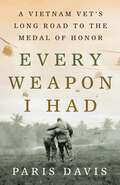
Every Weapon I Had: A Vietnam Vet's Long Road to the Medal of Honor
By Paris Davis. 2025
The story of a Green Beret commander's heroism during the Vietnam War, and the long fight to recognize his bravery.When…
Col. Paris Davis was selected to lead one of the Green Beret A-teams organizing resistance to Communist incursions into South Vietnam, his commanding officer warned him that some of his soldiers would resent his authority. This was no surprise; there were only a handful of Black officers in the Special Forces. Davis quickly won the respect of his soldiers, and would soon fight beside him as bullets snapped past and mortars exploded overhead.On June 18th, Davis led a group of inexperienced locals and Special Forces soldiers in an attack on a Viet Cong base in Bong Son. They were met by a superior enemy force, and Davis led the charge in a grueling firefight. He was seriously wounded, but he disobeyed a direct order to retreat until he dragged three injured Green Berets off the battlefield to safety.Every Weapon I Had is an inspiring tale of valor and sacrifice, set against the backdrop of major escalations in both the Vietnam War and the Civil Rights movement. It is also a story of deferred honor and delayed recognition; Davis earned the Silver Star and Purple Heart for his actions, but his nomination for the Congressional Medal of Honor was repeatedly “lost.” No official reason has ever been given for this oversight, but those who fought to correct it believe that it was motivated by racial prejudice. Davis was finally awarded the Medal in 2023, 58 years after the battle.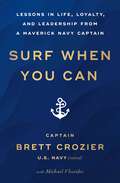
Surf When You Can: Lessons in Life, Loyalty, and Leadership from a Maverick Navy Captain
By Brett Crozier. 2023
Inspiring lessons learned from a lifetime of honor, service, and leadership from Captain Brett Crozier, the former commanding officer of…
the aircraft carrier USS Theodore Roosevelt and renowned Navy officer.Amid one of the darkest times in American history, it was a moment that captured the attention of the nation. Brett Crozier, captain of the most powerful and prestigious aircraft carrier in the United States Navy, walked off his ship for the last time while thousands of his sailors saluted and chanted his name in admiration. This remarkable moment occurred after Crozier made the decision to try to protect his sailors by pleading with his superiors for help when COVID-19 swept through the vessel. Two days later, he was relieved of command. Now, Crozier reflects on his life, career, and commitment to doing the right thing in a book that celebrates the power of kindness, the importance of teamwork, and the value of standing up for what you believe in. Through a series of &“engaging and candid&” (Proceedings magazine) stories set all around the world, Crozier takes us on the grand adventures of his extraordinary career and introduces the incredible people he met along the way. From his days as fighter pilot facing near-death experiences to commandeering suspected pirate vessels in the Persian Gulf, and of course, seizing any opportunity to enjoy one of his favorite hobbies—surfing—Crozier distills the lessons he has learned and the principles that have guided him, showing how you can apply them to your personal and professional life.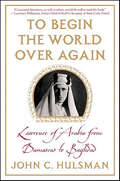
To Begin the World Over Again: Lawrence of Arabia from Damascus to Baghdad
By John C. Hulsman. 2009
The little known history of Lawrence of Arabia's passionate and tragic advocacy of Arab nationalism during the pivotal years following…
WWI and his template for nation building in the Middle East.Lawrence of Arabia is best remembered for the Oscar-winning film about his life. But there is a different T.E. Lawrence, a man who applied his unique experiences and extensive knowledge of the Arab world to a political vision for nation building in the Middle East that holds many lessons for today. Following the Arab Revolt, Lawrence embarked on a heroic effort, harnessing his celebrity to force the British to keep the promises made to their Arab allies. Alas, he was unable to stop the Western powers from carving up the Middle East at Versailles, thus laying the foundations for the ongoing instability in that region. Still, until the day he died, Lawrence continued to fight for Arab nationalism, famously saying: "Better to let them do it imperfectly than do it perfectly yourself, for it is their country, their war, and your time is short." By weaving together a gripping narrative of Lawrence's Middle East adventures and highlighting his surprisingly astute political thinking, John Hulsman teases out this and many other lessons to be learned from Lawrence about the Arab world.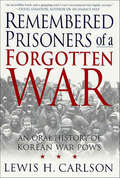
Remembered Prisoners of a Forgotten War: An Oral History of Korean War POWs
By Lewis H. Carlson. 2002
Remembered Prisoners of a Forgotten War presents a devastating oral history of Korean War POWs.The Korean War POW remains the…
most maligned victim of all American wars. For nearly half a century, the media, general public, and even scholars have described hundreds of these prisoners as "brainwashed" victims who uncharacteristically caved in to their Communist captors or, even worse, as turncoats who betrayed their fellow soldiers. In either case, these boys apparently lacked the "right stuff" required of our brave sons.Here, at long last, is a chance to hear the true story of these courageous men in their own words-- a story that, until now, has gone largely untold. Dr. Carlson debunks many of the popular myths of Korean War POWs in this devastating oral history that's as compelling and moving as it is informative. From the Tiger Death March to the paranoia here at home, Korean POWs suffered injustices on a scale few can comprehend. More than 40 percent of the 7,140 Americans taken prisoner died in captivity, and as haunting tales of the survivors unfold, it becomes clear that the goal of these men was simply to survive under the most terrible conditions.Each survivor's story is a unique and personal experience, from missionary teacher Larry Zeller's imprisonment in the death cells of P'yongyang and his first encounter with the infamous killer known as The Tiger, to Rubin Townsend's daring escape from a death march by jumping off a bridge in a blinding snowstorm. From capture to forced marches, isolation, permanent camps, and torture, Remembered Prisoners of a Forgotten War is one of the most fascinating and disturbing books on the Korean War in years-- and a brutally honest account of the Korean POW experience, in the survivors' own words.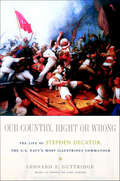
Our Country, Right or Wrong: The Life of Stephen Decatur, the U.S. Navy's Most Illustrious Commander
By Leonard F. Guttridge. 2006
Blazing sea fights and undercurrents of intrigue: these are among the compelling ingredients of a biography that brings to life…
the most illustrious and formidable figure of the United States Navy. His name is carried by more than two dozen towns and cities. Here at last is a full exploration of Stephen Decatur's complex character. Reckless in youth, cool yet audacious in combat, loved by those who sailed under his command yet plotted against by rivals in the race for glory, Decatur is brought to life in this enthralling sea story.Decatur's heroism became widespread news in 1804 when, sent to reclaim a captured U.S. vessel from Tripoli in the Barbary Wars, he ordered his men to set fire to the captured vessel and proceed to attack the sailors of the Tripoli fleet in hand-to-hand combat. His brilliance continued through the War of 1812, after which he was promoted to the highest naval rank of Commodore. Decatur not only proved dauntless on the quarterdeck but amazingly effective in Mediterranean diplomacy. His spectacular dealings with Islamic powers presaged America's twenty-first century involvement in the region.Readers will also learn the identity of the woman he forsook for a sophisticated beauty pursued by suitors as varied as Napoleon Bonaparte's younger brother and Aaron Burr. Through freshly discovered documents, many official, some intensely personal, biographer Leonard Guttridge traces the elements that sped Decatur inexorably into the shadow of murder. Here, at last, is the full story of the man who raised the most memorable toasts in the history of American celebrations, when he declared in 1816 "Our country! In her intercourse with foreign nations may she always be in the right; but our country, right or wrong!" At the Publisher's request, this title is being sold without Digital Rights Management Software (DRM) applied.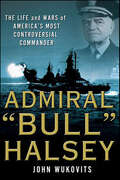
Admiral "Bull" Halsey: The Life and Wars of America's Most Controversial Commander
By John Wukovits. 2010
The definitive biography of America's best-known naval officer, who commanded the legendary fast carrier force during WWII.From the tragic aftermath…
of Pearl Harbor, when he fashioned America's first response to the attack, to the war's final day in Tokyo Bay when he witnessed Japan's surrender, Admiral William F. Halsey stamped a mighty imprint on the Pacific during World War II. He led or participated significantly in the Navy's first offensive strikes against the Marshall Islands and Wake Island, the Guadalcanal campaign, and the offensive toward Japan. As a commander, he never shied from engaging the enemy, but boldly entered into battle, ready for a fight. As a consequence, Halsey became the face of the Navy and its most attractive public relations phenomenon. Due to his bold tactics and quotable wit, Halsey continues to be a beloved and debated figure.In this balanced biography, historian John Wukovits illuminates the life of a man who ultimately deserves recognition as one the great naval commanders in U.S. history. Europe had Patton; the Pacific had Admiral William "the Bull" Halsey.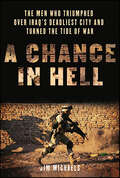
Jim Michaels's A Chance in Hell presents the riveting account of how one brigade turned Iraq's most violent city into…
a model of stability.Colonel Sean MacFarland arrived in Iraq's deadliest city with simple instructions: pacify Ramadi without destroying it. The odds were against him from the start. By 2006, insurgents roamed freely in many parts of the city in open defiance of Iraq's U.S.-backed government. Al-Qaeda had boldly declared Ramadi its capital. Even the U.S. military acknowledged that the province would be the last to be pacified.MacFarland laid out a bold plan. His soldiers would take on the insurgents in their own backyard. He set up combat outposts in the city's most dangerous neighborhoods. Snipers roamed the back alleys, killing al-Qaeda leaders and terrorist cells. U.S. tanks rumbled down the streets, firing point-blank into buildings occupied by insurgents. MacFarland's brigade engaged in some of the bloodiest street fighting of the war. Casualties on both sides mounted. Al-Qaeda wasn't going to give up easily--Ramadi was too important. MacFarland wasn't going to back down, either.A Chance in Hell tells how a handful of men turned the tide of war at a time when it appeared all hope was lost.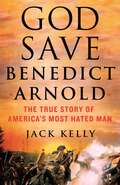
God Save Benedict Arnold: The True Story of America's Most Hated Man
By Jack Kelly. 2023
Finalist, New England Book Awards"Vivid." —The Wall Street Journal"A dazzling addition to the history of the American Revolution." ―Kirkus Review…
(starred)"Finally... a full and fascinating portrait of a true hero of the American Revolution, until he was visited by villainy. A riveting read." ―Tom Clavin, New York Times bestselling author of Follow Me to HellBenedict Arnold committed treason— for more than two centuries, that’s all that most Americans have known about him.Yet Arnold was much more than a turncoat—his achievements during the early years of the Revolutionary War defined him as the most successful soldier of the era. GOD SAVE BENEDICT ARNOLD tells the gripping story of Arnold’s rush of audacious feats—his capture of Fort Ticonderoga, his Maine mountain expedition to attack Quebec, the famous artillery brawl at Valcour Island, the turning-point battle at Saratoga—that laid the groundwork for our independence.Arnold was a superb leader, a brilliant tactician, a supremely courageous military officer. He was also imperfect, disloyal, villainous. One of the most paradoxical characters in American history, and one of the most interesting. GOD SAVE BENEDICT ARNOLD does not exonerate him for his treason—the stain on his character is permanent. But Kelly’s insightful exploration of Arnold’s career as a warrior shines a new light on this gutsy, fearless, and enigmatic figure. In the process, the book offers a fresh perspective on the reasons for Arnold’s momentous change of heart.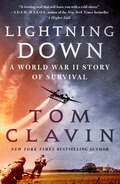
Lightning Down: A World War II Story of Survival
By Tom Clavin. 2021
An American fighter pilot doomed to die in Buchenwald but determined to survive.On August 13, 1944, Joe Moser set off…
on his forty-fourth combat mission over occupied France. Soon, he would join almost 170 other Allied airmen as prisoners in Buchenwald, one of the most notorious and deadly of Nazi concentration camps. Tom Clavin's Lightning Down tells this largely untold and riveting true story.Moser was just twenty-two years old, a farm boy from Washington State who fell in love with flying. During the War he realized his dream of piloting a P-38 Lightning, one of the most effective weapons the Army Air Corps had against the powerful German Luftwaffe. But on that hot August morning he had to bail out of his damaged, burning plane. Captured immediately, Moser’s journey into hell began.Moser and his courageous comrades from England, Canada, New Zealand, and elsewhere endured the most horrific conditions during their imprisonment... until the day the orders were issued by Hitler himself to execute them. Only a most desperate plan would save them.The page-turning momentum of Lightning Down is like that of a thriller, but the stories of imprisoned and brutalized airmen are true and told in unforgettable detail, led by the distinctly American voice of Joe Moser, who prays every day to be reunited with his family.Lightning Down is a can’t-put-it-down inspiring saga of brave men confronting great evil and great odds against survival.